Top 6 Best Fly Tying Scissors: Buyer’s Guide
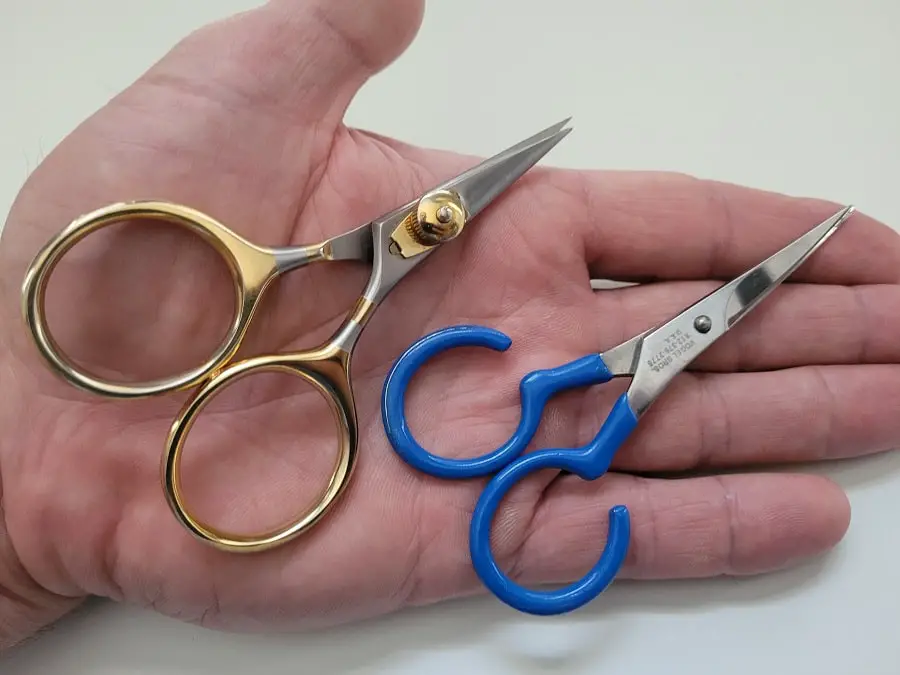
Fly tying scissors are essential for anyone who enjoys tying flies and needs an ideal pair of scissors for trimming and cutting various fly tying materials.
I’ve been tying flies for fun for over 30 years. Some years, I will tie over 1000 flies which I use for my guide service and to sell, so when I say good scissors make a big difference, they do.
I’ve included some tips and advice based on my experience, so keep an eye out for guide tips.
About Fly Tying Scissors
Unlike a standard pair of scissors with thick handles and blades, the best fly tying scissors are more precise and make it easier to trim your flies with greater precision. A quality pair of tying scissors is an excellent addition to your fly tying kit.
I have several pairs of dedicated scissors among my fly tying gear. You might want to look for just one pair that suits your fly tying needs, and I list those below, but you will likely will find it better to add more pairs to do specific types of trimming and cuts to your collection of fly tying tools.
You may also just be looking to upgrade from the cheaper scissors that come with most fly tying kits.
Here’s a close look at what makes fly tying scissors so useful and important and a quick look at six of my favorite pairs for fly fishing.
Best Fly Tying Scissors
These are the best fly tying scissors available but some have specific purposes. If you’re not sure what is right for you, see below this list for more information on what to look for in a good pair of scissors.
1. Dr Slick Razor Scissors
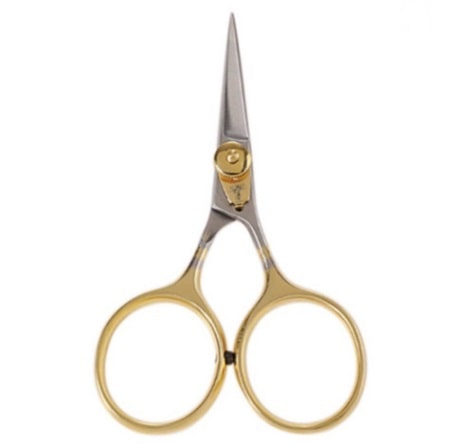
Dr Slick Razor scissors have flat and short blades made from stainless steel with a knurled tension knob that makes it perfect for cutting even fine materials.
The adjustable tension can make the cut more sharply as needed.
These are my favorite fly tying scissors. Although they are made from 440 grade J2 steel, to keep them sharp longer, I don’t cut course hair or other materials that might dull them quicker.
2. Loon Outdoor Razor Scissors
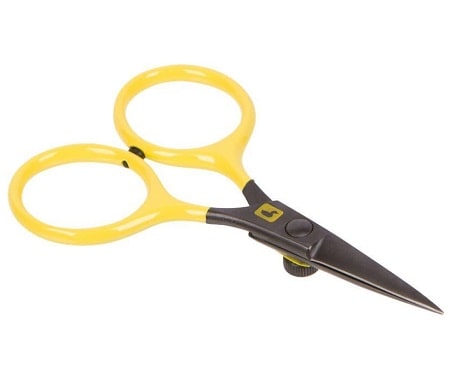
A knurled tension knob gives the scissors the perfect cutting tension for just about any material.
The Outdoor Razor Scissors are perfect for tucking into a fly fishing vest and carrying into the field for changing flies and making emergency changes to your flies.
3. Dr Slick Tungsten Carbide Scissors
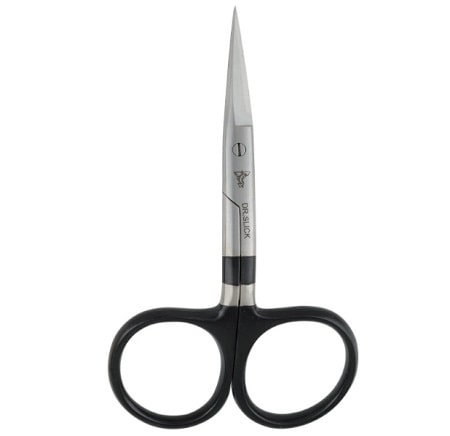
The Dr Slick scissors with a flat tungsten carbide blade are incredibly sharp and have short blades with longer handles and oversized finger holes to give you the best cutting power.
The Dr Slick scissors have a smooth edge and are very portable as well as durable for cutting natural materials used in fly tying.
4. Kopter Ultimate Scissors Straight
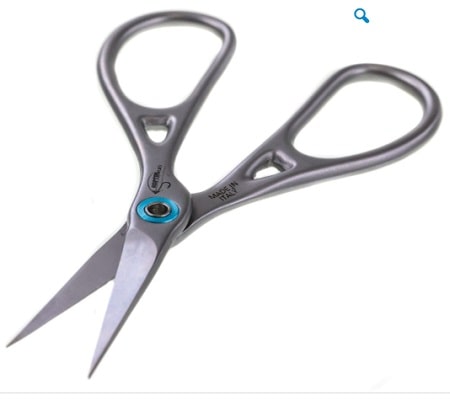
Oversized finger loops and sharp, flat stainless steel blades make the Hareline Kopter Ultimate an ideal pair of scissors for tying and trimming your flies.
They have a very fine micro tip for precision use and ideal cutting power.
5. Dr Slick Hair Scissors – Best Serrated Option
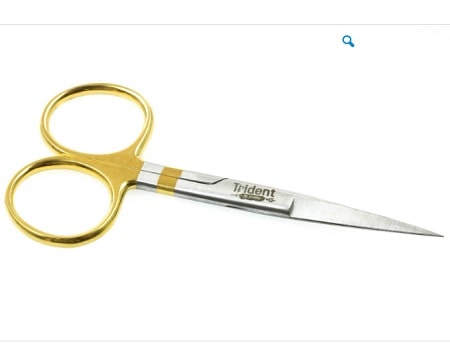
The Dr Slick scissors have serrated blades that are great for gripping material while you trim or cut it for tying flies.
They might be the best serrated scissors on the market for cutting natural materials and more durable artificial ones when tying your flies.
6. Westcott Titanium Bonded Fine Cut Scissors
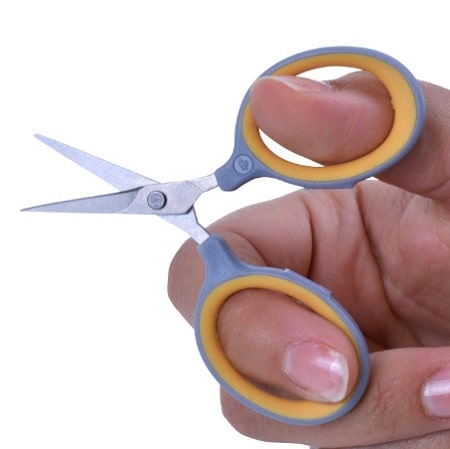
The fine-cut scissors have stainless steel and titanium blades with very fine points. They are short and have oversized finger loops that are coated for improved gripping power.
A new pair is very affordable and would set you back less than $10.
These stay sharp even after long use so these are good for fine cuts or for cutting bulky materials like deer hair that might dull other scissors fast.
What to Look for in a Good Pair of Fly Tying Scissors
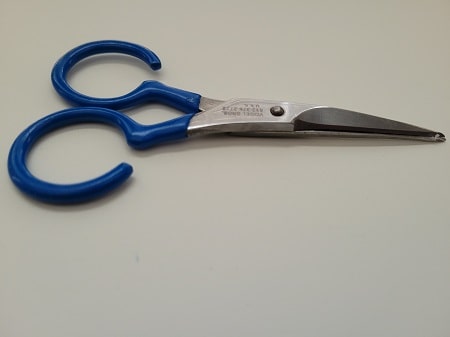
There are many options for fly tying scissors and many different blades and designs. Choosing the ideal pair requires knowing what kinds of cuts and trimming you want it to do. And believe me, this matters.
Different types of blades and designs for tying scissors offer various advantages.
Here are some of the construction elements for fly tying scissors that you should consider when you want to buy the best fly tying scissors for your needs.
Guide Tip: Certain materials like synthetic material and hair can dull scissors faster. For this reason, I recommend 2 or 3 pairs for different applications. Also, see my tip below for what to do with dull scissors.
Length Of The Blade
A short and narrow blade on fly tying scissors makes them ideal for smaller and lighter flies. Long blades can give you a better cutting surface when you are cutting hide, lengthwise along feathers, and other materials that you might use to wrap or tie to the fly.
Shorter blades give you more leverage when you are making your cuts while longer blades help you to cut lines more evenly.
Serrated or Straight Blasde
The options for the best fly tying scissors include straight or serrated blades. Serrated blades have serrations that hold onto the material and make it easier to cut it. The blades are the best to use with you are cutting hide or other tough material.
A straight blade refers to one that is not serrated and often is used on razor scissors. Straight-bladed scissors usually are sharper and thinner than a serrated blade and are great for trimming excess material and snipping lines while you are fly tying. Some fly tying scissors also pair a straight blade with a serrated blade to give you the best of both.
Points of Scissors
Fly tying scissors have different points at the ends of the blades that do different things. A fine point is great for fine-trimming and removing excess material that you have tied to a fly. A more blunt or rounded point gives you more blade strength for cutting tougher natural and synthetic materials.
The fly tying scissors also might have curved blades that come to a point to make it easier to finely trim smaller flies or make more precise cuts on large flies.
Pivot Points
The pivot point refers to where the blades meet and pivot and directly affects the blade length and the amount of leverage that you get from the handles of the best scissors. The closer the pivot point is to the end of the blades, the shorter the blades are the more leverage you get from the handles.
The farther away the pivot point is, the longer the cutting surface and the less leverage you get with the handles. Some pivot points include a knurled knob that gives you adjustable tension.
Size Matters
The size of the fly thing scissors makes a big difference in their effectiveness. Most are about the size of surgical scissors and about as sharp so that you can make very precise cuts and trim your flies.
The sharpest scissors that are made from surgical stainless steel easily could double as a pair of scissors for medical use, but they also are ideal for tying and trimming flies. Narrow blades that are just long enough to tie and trim delicate flies generally are the best and won’t wear out your fingers during long tying sessions.
Finger Holes
The finger holes help to make the scissors more comfortable to use and easier to place the blades where you want them. You want the finger holes larger enough for your thumb and forefinger to slip in and out easily. You might want an oversized finger hole that enables you to fit two fingers into it for even more cutting power and leverage.
Open Loop
An open loop means at least one of the finger loops is not a fully enclosed circle or finger loop through which you place one or two fingers. The scissors likely will have a thumb hole and might have an open loop where the fingers go so that you can use the scissors quickly and easily — even if you are wearing gloves.
Price
You can spend a relatively small amount of around $20 or less for a perfectly good pair of fly tying scissors. You also could spend hundreds of dollars on a pair of the best scissors for fly tying.
I recommend setting a budget and choosing a good pair that falls within your preferred price range. You always can buy another pair later on if you find your first pair lacking in any way.
Types of Scissors:
There generally are five types of scissors for fly tying from which to choose. Here’s a brief look at each of them.
General Purpose
A general-purpose pair of scissors is a do-all type that you might use for any purpose. You might buy a pair for cutting fishing line and decide to use it while fly tying and have good results. You also might learn their specific weaknesses.
Arrow Point
The arrow point refers to how the blade looks when viewed from the aide. A small notch that is just ahead of the pivot point gives the blades an arrowhead appearance. That notch is there for a reason — to cut wire and other stubborn materials that might damage the rest of the blade. Its nearness to the pivot point gives you maximum leverage for cutting wire, feathers, and tougher synthetic materials.
Razor Scissors
Razor scissors have a smooth blade that is very sharp and might be made from ice tempered stainless steel. They are the sharpest scissors you can buy and are terrific for cutting material and trimming your flies. Some razor scissors have a knurled tension knob that helps you to dial in the perfect cutting power.
Utility Scissors
Utility scissors are a pair of scissors that could be used for a variety of medical purposes, such as cutting bandages, removing shirts, or trimming cast material. They also are great for fly tying and usually are made from stainless steel or tungsten carbide. They stay sharp for a very long time and can cut delicate material, elk hair, or deer hair with equal ease.
Hair Scissors
Hair scissors are the ones that your barber or hair stylist would use to trim your hair, mustache, or beard. They often have longer blades made from stainless steel and are a good all-around pair of scissors that work well for fly tying.
Spring Loaded Scissors
Spring-loaded scissors have an internal spring mechanism that opens them more easily so that you can focus on applying cutting pressure on tougher materials. Many have a serrated blade instead of smooth edges so that fly tiers can use them to cut tougher material, like deer hair and hide.
Blade Design
We already discussed blades a bit in the sections above, but let’s tale a quick look are how blade design affects the performance and use of the best fly tying scissors.
Short Blade, Fine Point
When you want to make small and precise cuts, a short blade with a fine point is the best for the job. They enable you to place the blades exactly where you need them and make minute changes while tying your own flies.
Long Blade Fine Point
An experienced fly tier will find a long blade with a fine point to be best for cutting thread, foam strips, and other commonly used materials. Most have a non serrated blade that is made from stainless steel.
Long Blade Rounded Nose
A long blade with a rounded nose gives you a bit more cutting power for longer material and shaping your flies.
Straight v. Curved Blades
A straight stainless steel blade can help with trimming your flies while curved blades enable you to make more exact cuts and is very handy for cutting line and trimming your flies.
Smooth, Serrated, or Combo Blades
Smooth and serrated fly tying scissors generally serve different purposes. Smooth blades cut light material and lines, while serrated blades a better for cutting thicker and more durable materials. A combo would have one smooth blade and one serrated blade so that it will hold materials in place while cutting them.
Steel vs Tungsten Carbide
A stainless steel blade is the most common and is terrific for combining strength and sharpness. A tungsten carbide blade also is sharp and durable but often costs more.
Micro tip
A micro tip is perfect for making very small changes to your flies and trimming them to perfection.
Uses For Worn-out Scissors
Scissors will get dull after time. I use my older dull scissors for cutting certain material that might ruin a good sharp pair of scissors. Things like lead wire, tinsel, wire ribbing, and coarse hair.
You can also use them for more general fishing purposes like tying on lures and cutting line.
Don’t forget to check out Best Fly Tying Hooks and The 21 Best Fly Tying Books.
Best Fly Tying Scissors
If you have any questions or comments about the best fly tying scissors, or if you want to share your favorite scissors or tip, let us know in the comment section below.
Tight Lines
Graham
